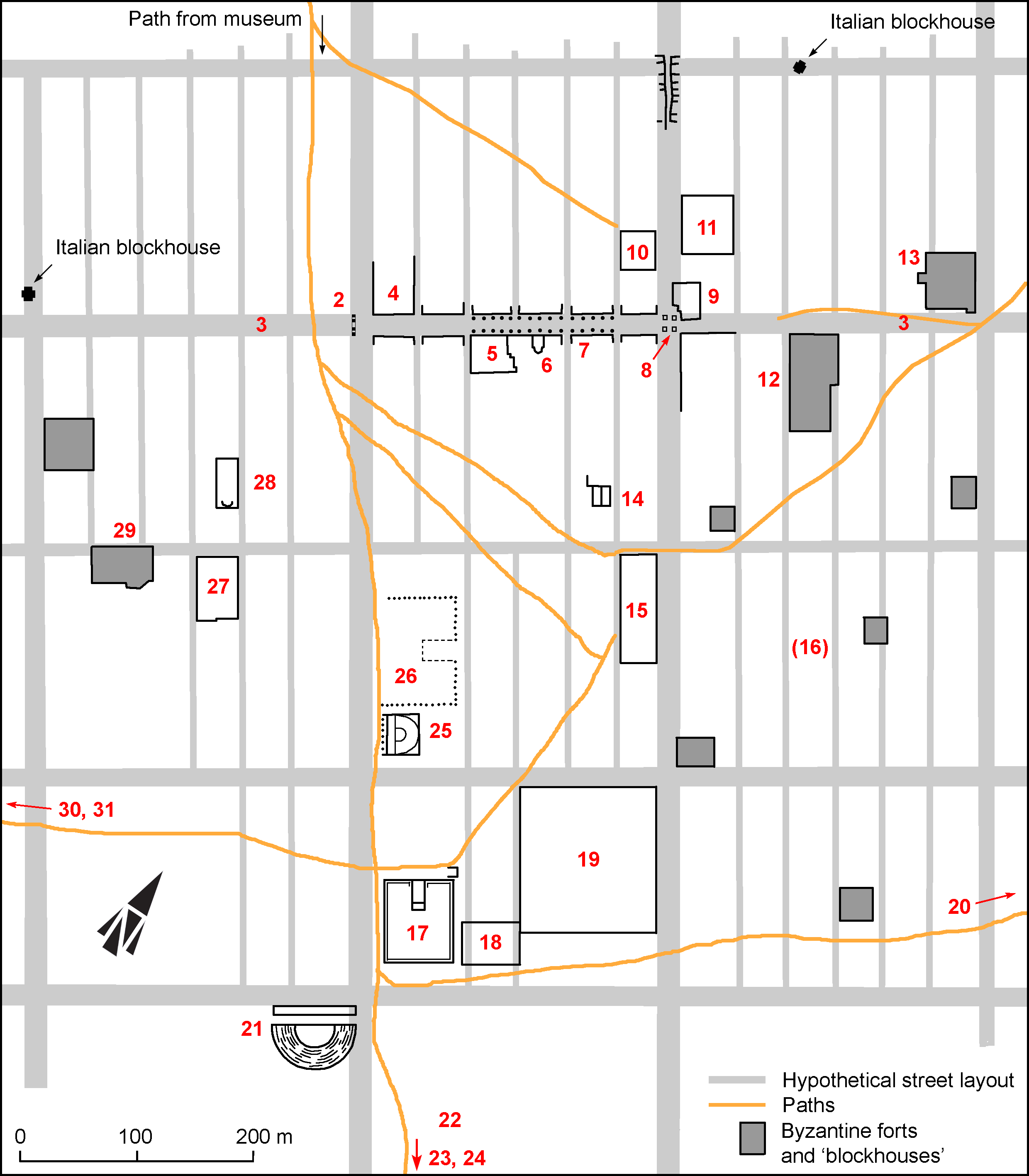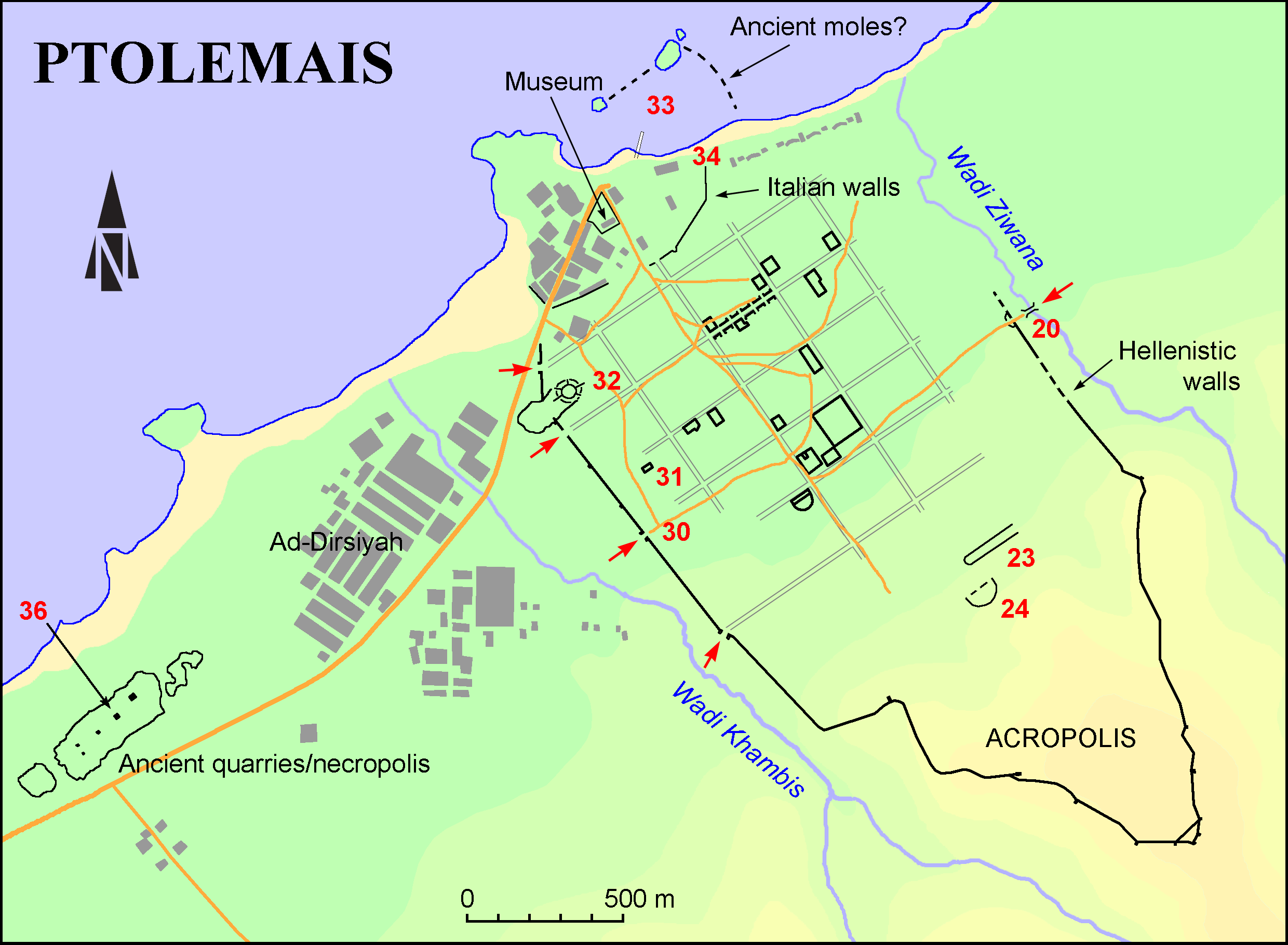EpiDoc XML:
IGCyr0337002
Trismegistos ID:
6016
Source description
Support: Limestone block, probably belonging to the same monument as IGCyr0338002; recut at right and reused upside down in Roman times (w: 0.73 × h: 0.35).
Layout: Inscribed on the face in three lines centered along vertical axis.
Letters: 0.06; carefully cut, similar to IGCyr0338002.
Date: Between 251 and 168 BC (context, lettering, reign).
Findspot: Seen by all visitors since Pacho (1825) at Ptolemais ➚: recut and reused in the rostra of the Square of the Cisterns, 5th file, 2nd block from left.
Last recorded location: Seen by C. Dobias-Lalou in 1979 at the place of re-use in the Square of the Cisterns.
Text constituted from: Transcription from stone (CDL).
Bibliography
Letronne in Pacho 1827, pl. LXXIV and pp. 397-399 (= Letronne 1828, pp. 259-261), whence CIG 5184 and OGIS 33; Oliverio 1932-1933, pp. 68-69, n. 3, fig. 7, whence SEG, 9.357; IGCyr 033700 ➚.
Cf. Moretti 1976 (= Moretti 1990, pp. 343-348), whence SEG, 26.1838; Robert, BE, 1977.593; Laronde 1987, pp. 398, 402, whence SEG, 38.1905; Marquaille 2003, and Dobias-Lalou, BE, 2005.620, whence SEG, 53.2028; Mueller 2004, and Dobias-Lalou, BE, 2007.568, whence SEG, 54.1779bis; Criscuolo 2001, whence SEG, 51.2213; Caneva 2016, p. 213; Rosamilia 2023, p. 55-56 (date).
Text
Apparatus
1: θεὰ[ν Φιλάδελφον] OGIS, Oliverio 1932-1933, crisculo2001b, IGCyr: θεὰ[ν Φιλοπάτορα] Laronde 1987, Caneva 2016 Also alternative reading for Dittenberger in OGIS.
2: [θεῶν Σωτήρων]: [θεῶν Εὐεργετῶν] Laronde 1987, Caneva 2016 Also alternative reading for Dittenberger in OGIS.
French translation
(scil. La statue de la) reine Arsinoè, Déesse [Philadelphe], fille de Ptolémée et de Bérénice, [Dieux Sôtères] (scil. a été érigée par) la cité.
English translation
(scil. The statue of) queen Arsinoe, Goddess [Philadelphos], daughter of Ptolemy and of Berenice, [Gods Soteres] (scil. has been dedicated by) the city.
Italian translation
(scil. La statua della) regina Arsinoe, Dea [Filadelfo], figlia di Tolemeo e di Berenice, [Dèi Soteri] (scil. è stata eretta dalla) città.
Arabic translation
تمثال الملكة آرسينوي، المؤلهة [فيلادلفوس]، ابنة بطليموس وبيرنيكي، [المؤلهين سوتيرس]، (كان قد نُصبَ) من قبل المدينه.
Commentary
At Ptolemais there are three similar bases for members of the Lagid family (IGCyr0337002, IGCyr0338002 and IGCyr0843002), which were re-used in the same Roman monument that seems to lay upon the foundations of a Hellenistic monumental base to which they probably all belonged, perhaps along with a fourth one, now lost. The Roman monument is part of the so-called Square of the Cisterns, which may have been formerly either the gymnasium (Stucchi 1975, p. 128, footnote 3) or the agora (Laronde 1987, p. 398).
The possibility of having here queen Arsinoe III instead of Arsinoe II, left open by Dittenberger, admitted by Laronde, was recently sustained again by Caneva, who argued that no exact parallel was to be found for the titulature of Arsinoe II. However, at line 2 their restoration with 13 letters seems too long for the space available: the layout of the inscription is axial and at line 3, the text is wholly preserved with a vacat at left end, corresponding to 9 letters at lines 1 and 2. We prefer thus the shorter restoration, i.e. 10 letters at line 1 and 11 letters (but not 13) at line 2. The authorities at Ptolemais were not too strictly submitted to the subtilities of the Alexandrian chancellery.
The present dedication may have been erected earlier than the two others, which, as Criscuolo 2001 established, were modelled on it between 168 and 164 BC in order to form a monumental base. However, the lettering does not show a span of time as long as one century (Arsinoe died in 270).
It is not clear whether the city mentioned at l. 3 might have been still Barka and not yet Ptolemais, for the cult of Arsinoe was specially developed in harbours and not necessarily in the city-centre; however, as we now know that Ptolemais was founded probably after 260 (Laronde 1987, p. 398) and certainly before 251 (Mueller 2004), it is highly plausible that the dedication to Arsinoe was erected by the city of Ptolemais in a prominent place. Rosamilia 2023 in turn, argueing about the deliberative process giving way to the erection of a honorific monument by a city in Cyrenaica, shows that this is one of the most ancient instances in the region.
CC BY-NC-SA 4.0 Deed Attribution-NonCommercial-ShareAlike 4.0 International License.
All citation, reuse or distribution of this work must contain a link back to DOI: https://doi.org/10.60760/unibo/igcyrgvcyr2 and the filename (IGCyr000000 or GVCyr000), as well as the year of consultation.


